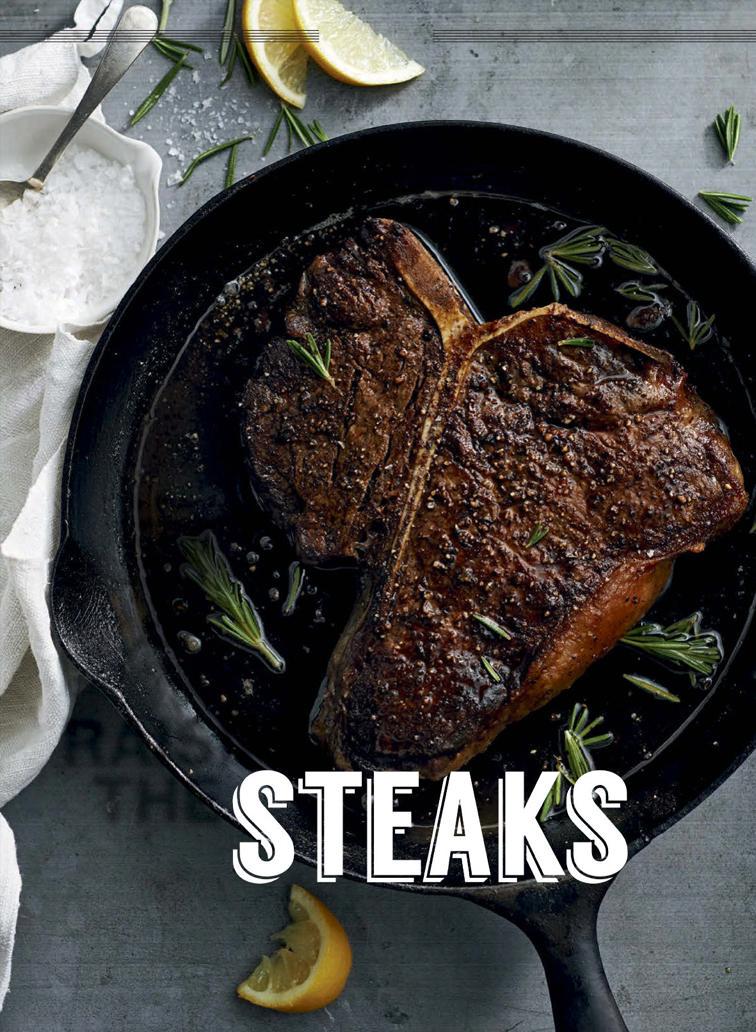
17 minute read
RAISING THE STEAKS
from CL - June 2015
STEAK FLORENTINE
p. 114
Advertisement
This is your one-stop guide to selecting and cooking the perfect steak, no matter what cut you choose.
FOOD STYLING, ASHLEY DENTON. PROP STYLING, SASHA SEYMOUR
RAISING THE
BY IRENE FONG & THE TEST KITCHEN PHOTOGRAPHY BY JEFF COULSON
Steak Florentine
Hands-on time: 30 minutes Total time: 45 minutes Makes: 4 to 6 servings
A thick-cut T-bone or porterhouse works best for this Italian-style steak. Standing it up on the base of the T-bone heats up the bone, which helps cook this extra-thick cut through to the centre. The tenderloin piece cooks faster than the strip loin, so serve it to the people who prefer their steak a bit more done.
1 kg beef T-bone grilling steak (1½ inches/4 cm thick) 2 tsp olive oil 1 tsp chopped fresh rosemary ¾ tsp fine sea salt ½ tsp pepper lemon wedges
Brush both sides of steak with oil and sprinkle with rosemary. Let stand for 10 minutes.
Sprinkle both sides of steak with salt and pepper, pressing to adhere. Place on greased grill over mediumhigh heat. Grill, uncovered, rotating in quarter-turns and turning as necessary to prevent overbrowning, until instant-read thermometer inserted in centre reads 125°F (52°C), 18 to 20 minutes. Using tongs, stand steak up on base of T-bone and grill until instant-read thermometer inserted in centre reads 130°F (55°C), about 4 minutes.
Remove to rack and let rest, uncovered, for 5 minutes or until instant-read thermometer inserted in centre reads 135°F (57°C). Slice across the grain and serve with lemon wedges.
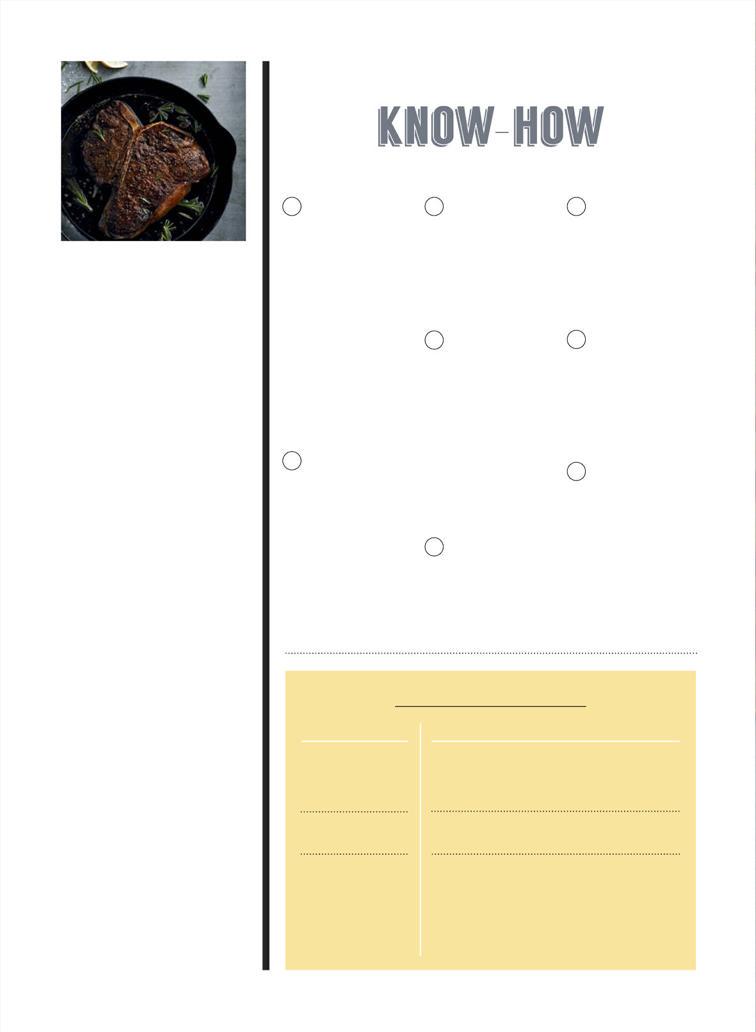
PER EACH OF 6 SERVINGS: about 273 cal, 28 g pro, 17 g total fat (7 g sat. fat), trace carb (trace dietary fibre, 0 g sugar), 66 mg chol, 350 mg sodium, 302 mg potassium. % RDI: 2% calcium, 19% iron, 3% folate.
• STEAK•
DON’T EVEN PREHEAT YOUR BARBECUE TILL YOU’VE READ THESE EIGHT HELPFUL TIPS.
1 3
VACUUM-SEALED STEAKS STAY FRESH LONGER
They can be refrigerated for up to three days or frozen for up to nine months without the risk of freezer burn. Don’t worry if the colour of shrink-wrapped steak is darker than you’re used to—once it’s exposed to air, it returns to its natural bright red colour. 2
LEAVE STEAK IN THE FRIDGE JUST UNTIL YOU’RE READY TO COOK
There’s no benefit to bringing steak to room temperature before cooking. It’s best to keep the meat chilled until you’re ready to grill to prevent food-borne illness.
PAT STEAKS DRY WITH PAPER TOWEL BEFORE SEASONING AND COOKING
This helps the meat develop a nice brown crust and well-defined grill marks. 4
PRICK MARINATING STEAKS ALL OVER WITH A FORK BEFORE THEY MARINATE
This breaks down and disrupts the tough muscle fibres, making the meat easier to chew. Food-safety note: Pierced steaks should be cooked to at least 145°F (63°C). 5
LET COOKED STEAKS REST ON A WIRE RACK
This lifts them away from run-off juices, preserving the crust.
6
IF YOU DON’T SEE THE THICKNESS YOU WANT, BUY A WHOLE ROAST
Ask your butcher to slice it or divvy the roast into steaks yourself. 7
IF YOU TEND TO OVERCOOK STEAK, CHOOSE THICKER CUTS
It takes longer for the centres to cook through, making them less likely to overcook. 8
CHOOSE THE RIGHT THICKNESS
If cooking to mediumrare or rare, choose steaks that are at least ¾-inch (2 cm) thick to prevent overcooking. If cooking to mediumwell or well, go for steaks that are thinner than ¾ inch (2 cm).
TROUBLESHOOTING
PROBLEM
You want a thick steak but don’t want to pay for an entire rib eye or strip loin.
You don’t have a barbecue.
You like steak cooked mediumwell or well, but by the time it’s cooked in the centre, the outside is burned. SOLUTION
Ask the butcher for medallion cuts of your desired steak. These are sized perfectly for a single serving yet are just as thick and impressive as full-size steaks.
A grill pan, indoor grill or skillet on medium-high heat works just as well.
Start the steak on the grill or pan to develop a nice crust, then finish cooking in a 375°F (190°C) oven to your desired doneness. The gentle heat of your oven cooks the steak evenly throughout without overbrowning the crust. This is also a great method for cooking thick (1½ inches/4 cm) steaks.
— JOYCE PARSLOW, CANADA BEEF
Classic Marinated Flank Steak

Hands-on time: 20 minutes Total time: 8½ hours Makes: 6 to 8 servings
Flank steak is a great option for serving a large crowd because you cook it whole, meaning there’s only one steak to turn on the grill, rather than several. Balsamic vinegar adds bold flavour to the marinade. For a subtler taste, opt for a light- to medium-bodied red wine, such as Pinot Noir or Merlot, instead.
½ cup balsamic vinegar or dry red wine 3 tbsp Dijon mustard 3 tbsp olive oil 4 cloves garlic, finely grated or pressed ½ tsp each salt and pepper 1 beef flank marinating steak (900 g)
In small bowl, whisk together vinegar, mustard, 2 tbsp of the oil, the garlic and half each of the salt and pepper. Using fork, prick steak all over on both sides. Place in large resealable plastic bag or shallow dish; pour in vinegar mixture, massaging or turning steak to coat. Seal bag or cover dish and refrigerate for 8 to 24 hours. Remove steak from marinade; discard marinade. Pat steak dry and brush with remaining oil; sprinkle with remaining salt and pepper. Place on greased grill over medium-high heat. Grill, uncovered and turning at least twice, until instant-read thermometer inserted in centre reads 140°F (60°C), 10 to 12 minutes. (Tip: See chart on page 118 for more ways to tell doneness.) Remove to rack and let rest, uncovered, for 5 minutes or until instant-read thermometer inserted in centre reads 145°F (63°C). Slice across the grain.
PER EACH OF 8 SERVINGS: about 195 cal, 25 g pro, 9 g total fat (3 g sat. fat), 1 g carb (trace dietary fibre, 1 g sugar), 50 mg chol, 153 mg sodium, 238 mg potassium. % RDI: 1% calcium, 16% iron, 2% folate.
HOW-TO VIDEO
Learn how to slice a steak across the grain at canadianliving.com/steak.
There are three main types: grilling steaks, marinating steaks and simmering steaks. Grilling steaks are quick-cooking, naturally tender and can go straight from fridge to grill. Marinating and simmering steaks are generally less expensive, but they need a little TLC to become tender. Here’s what you need to know.
TENDERLOIN
a.k.a. filet mignon, fillet steak, beef fillet,
châteaubriand $$$$ THE 411: Tenderloin has a soft buttery texture and subtle flavour yet is leaner than most other tender cuts. Be wary of overcooking this steak; it’s best cooked to medium or under. This is the cut of choice for raw dishes, such as steak tartare and beef carpaccio.
Simply season and grill, broil or panfry—no marinating necessary.
RIB EYE
a.k.a. entrecôte, rib steak, cowboy
steak (if bone is attached) $$$$ THE 411: This cut is easily identified by the small pocket of fat (called the plug) that separates the two muscles. Extensive marbling (the white lines of fat) gives this cut its signature juiciness and flavour.
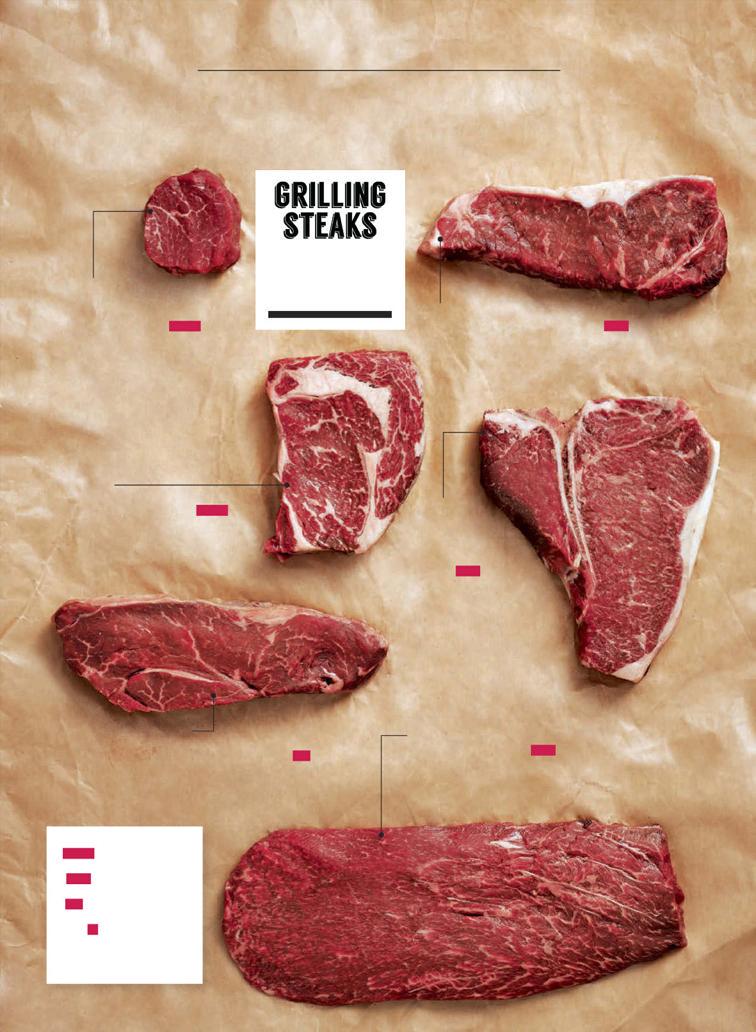
TOP SIRLOIN
a.k.a. baseball steak (when thickly cut),
culotte, centre-cut sirloin, cap steak $$ THE 411: Less expensive than strip loin, tenderloin or rib eye, this cut delivers on tenderness and is more flavourful than many of its pricier alternatives. It’s ideal for the budget gourmet.
PRICE GUIDE
$$$$ = Special-occasion splurge ($21 to $40 per pound) $$$ = Weekend splurge ($16 to $20 per pound) $$ = Weeknight-friendly ($11 to $15 per pound) $ = Great value ($7 to $10 per pound)
STRIP LOIN
a.k.a. New York strip, strip steak $$$ THE 411: This steak is known for its outstanding flavour and good marbling. While not as tender as rib eye, it’s leaner and offers a beefier flavour.
T-BONE
a.k.a. club steak, porterhouse (when cut to include a large tenderloin
section) $$$ THE 411: This cut gets its name from the T-shaped bone that separates the larger strip loin on one side of the steak from the smaller tenderloin on the other. Consider it a twofor-one that’s good for sharing or for those who can’t choose between the flavour of strip loin and the texture of tenderloin.
FLATIRON
a.k.a. top blade flatiron $$$ THE 411: Considered a great substitute for tenderloin, this extremely tender steak is gaining popularity. Always check the label to ensure it’s a top blade flatiron cut, as there is also a top blade simmering steak.
ROUND
a.k.a. inside round, outside round, eye of
round, rump, minute steak, fast-fry $ THE 411: This cut comes in three variations: eye of round, inside round and outside round. Eye of round is very lean and mild; it’s best prepared with strong marinades. Inside and outside rounds have a stronger flavour; inside round is the more tender of the two.
Eye of round a.k.a. London broil $$ THE 411: This large oval steak has a delicious beefy flavour with little to no connective tissue, making it quite tender when sliced across the grain. Marinating greatly improves the texture, but you can get away without it in a pinch. Its tapered ends cook faster than the middle—great for feeding a group that prefers a variety of options for doneness.
These cuts are big on flavour but benefit from being tenderized with a fork (see tip #4, page 114) and marinated for eight to 24 hours before cooking. Their lower price makes them a good weeknight option.
Inside round Outside round
SIRLOIN TIP
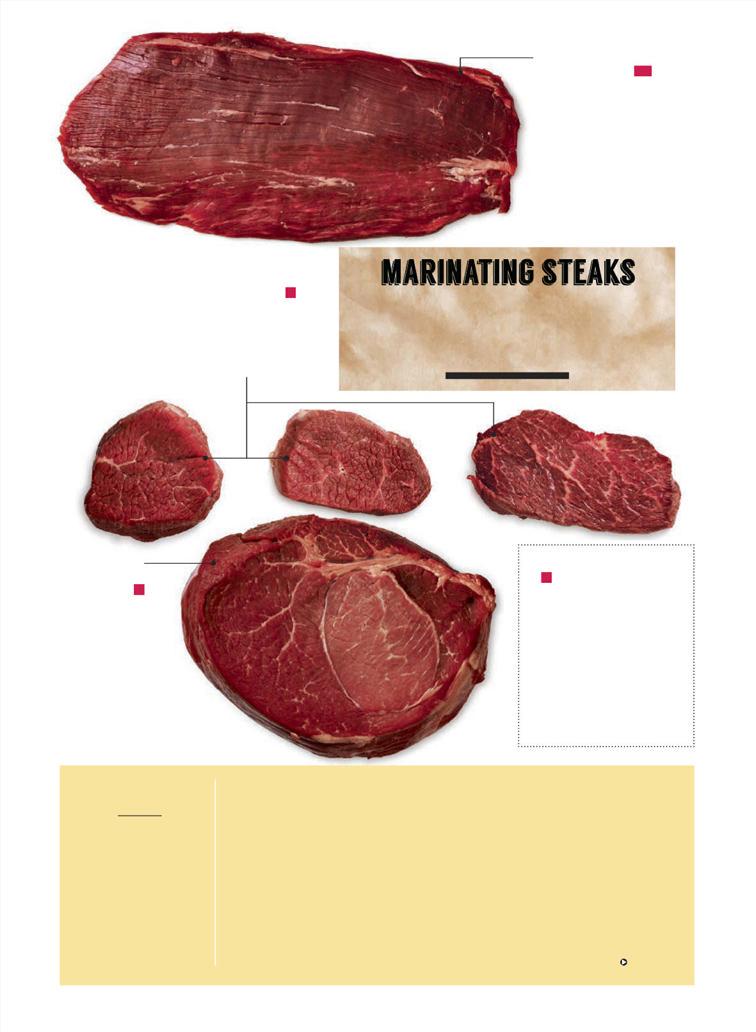
a.k.a. sandwich steak,
knuckle steak $ THE 411: This is a very lean cut with good flavour. Because of its minimal marbling, this steak really needs to be pierced and marinated to tenderize the meat before cooking. Often sold as a roast, it can easily be cut into individual steaks.
SIMMERING STEAKS
$ Think of these as roasts that serve two to three people. They’re relatively tough yet flavourful and should be cooked using moist methods, such as braising or slow cooking. The most common simmering steaks are blade and cross rib. Blade is slightly more tender than cross rib, but both should be cooked low and slow to maximize tenderness.
SOMETHING NEW
Insiders know these lesser-known cuts are some of the best. If you don’t see these steaks at the meat counter, ask your butcher—he or she may have them in the back.
OUTSIDE SKIRT AND
INSIDE SKIRT These flavourful marinating steaks come from the underbelly of the cow. The outside skirt is thinner and more marbled than the inside skirt, but treat them both the same as you would flank steak. They’re great for fajitas and stir-fries.
HANGER Also called hanging tender or onglet, this grilling steak comes from the cow’s plate (front section of the belly) and is known for its incredibly rich flavour. Rumour has it that butchers loved the taste so much, they would keep the hanger for themselves, making it relatively unknown to consumers until recently.
TRI TIP This lean grilling steak comes from the bottom sirloin and is easily recognized by its triangular shape. Praised for its beefy flavour and tenderness, it’s an excellent substitute for top sirloin.
BAVETTE This popular bistro grilling steak is also known as bottom sirloin flap. Taken from just above the flank, bavette is more tender than flank but not as tender as rib eye or strip loin. It’s great for grilling and best cooked quickly over high heat, then sliced across the grain.
RARE
Very soft to the touch with a bright red warm centre
MEDIUM
Completely pink throughout
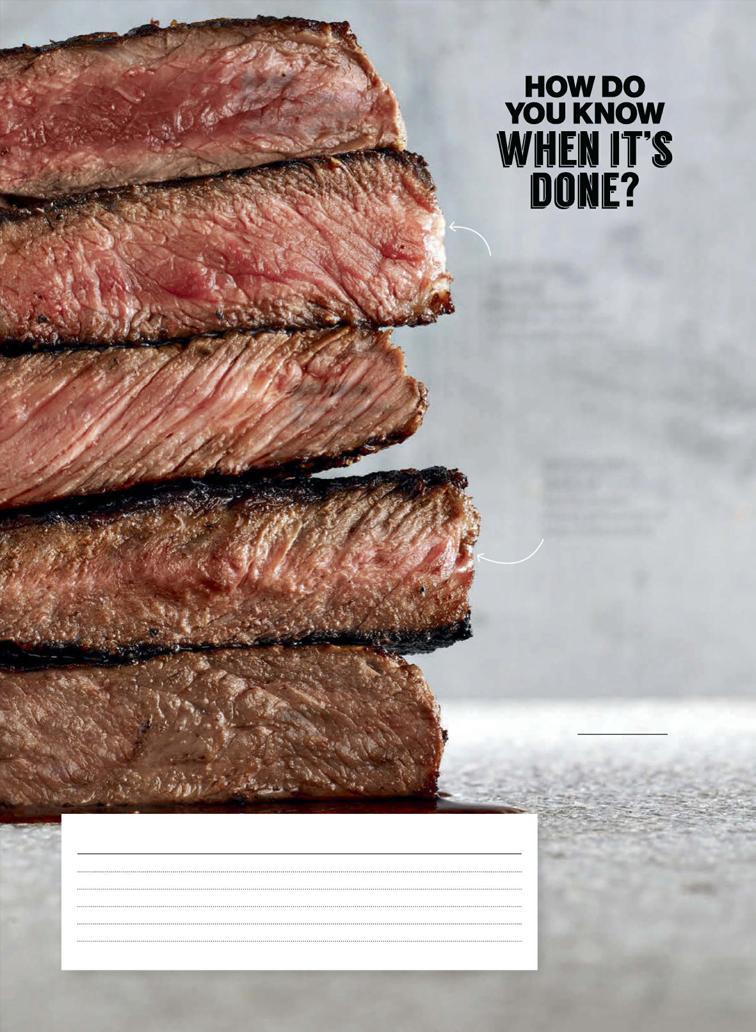
MEDIUMRARE
Soft to the touch and pink inside with a red warm centre
MEDIUMWELL
Mostly brown inside with a hint of pink in the centre
WELL
Firm to the touch with a uniform brown colour throughout
RARE MEDIUM-RARE MEDIUM MEDIUM-WELL
135°F/57°C 145°F/63°C 160°F/71°C 165°F/74°C
¼ inch 45 seconds 1 minute 2 minutes 3 minutes ½ inch 3 minutes 4 minutes 5 minutes 6 minutes ¾ inch 4 to 5 minutes 6 to 7 minutes 8 to 10 minutes 10 to 12 minutes 1 inch 8 to 10 minutes 10 to 12 minutes 12 to 14 minutes 14 to 16 minutes 1½ inches 14 to 16 minutes 16 to 19 minutes 22 to 26 minutes 26 to 30 minutes 2 inches 18 to 22 minutes 24 to 28 minutes 28 to 32 minutes 33 to 36 minutes
CARRYOVER COOKING
Steak continues to cook an additional five to 10 degrees after it’s removed from heat. Steaks thinner than ¾ inch (2 cm) should come off the heat 10 degrees before they reach desired doneness. Steaks that are ¾ inch (2 cm) or thicker should come off the heat five degrees before desired doneness.
Steakhouse Rib Eye With Béarnaise Sauce
Hands-on time: 30 minutes Total time: 30 minutes Makes: 6 servings
In The Test Kitchen, we cook rib eyes to medium-rare—just enough to render some of the fat but not enough to toughen the meat. This béarnaise recipe yields a full cup; leftovers don’t keep well in the fridge, so if you’re serving a smaller crowd that won’t need all of the sauce, consider substituting with our Shallotand-Herb Compound Butter (see below).
Béarnaise Sauce:
1 shallot, finely chopped 2 tbsp white wine vinegar pinch pepper 4 egg yolks ½ cup butter, melted 1 tbsp chopped fresh tarragon
Steaks:
3 beef rib eye grilling steaks (each 340 g and 1 inch/2.5 cm thick) 2 tbsp olive oil ½ tsp each salt and pepper
Béarnaise Sauce: In small saucepan, bring shallot, vinegar, pepper and ¼ cup water to simmer over medium heat. Cook until reduced by half, about 3 minutes. In heatproof bowl, whisk egg yolks until pale; whisk in shallot mixture. Set bowl over saucepan of simmering water; cook, whisking constantly, until sauce is thick enough to coat back of spoon, about 5 minutes. Slowly drizzle in butter, whisking constantly. Whisk in tarragon. Remove saucepan from heat and set bowl of sauce over top to keep warm. Steaks: Brush both sides of steaks with oil and sprinkle with salt and pepper. Place on greased grill over medium-high heat. Grill, uncovered and turning at least twice, until instant-read thermometer inserted in centre reads 140°F (60°C), 10 to 12 minutes. (Tip: See chart on page 118 for more ways to tell doneness.) Remove to rack and let rest, uncovered, for 5 minutes or until instant-read thermometer inserted in centre reads 145°F (63°C). Slice across the grain and serve with Béarnaise Sauce.
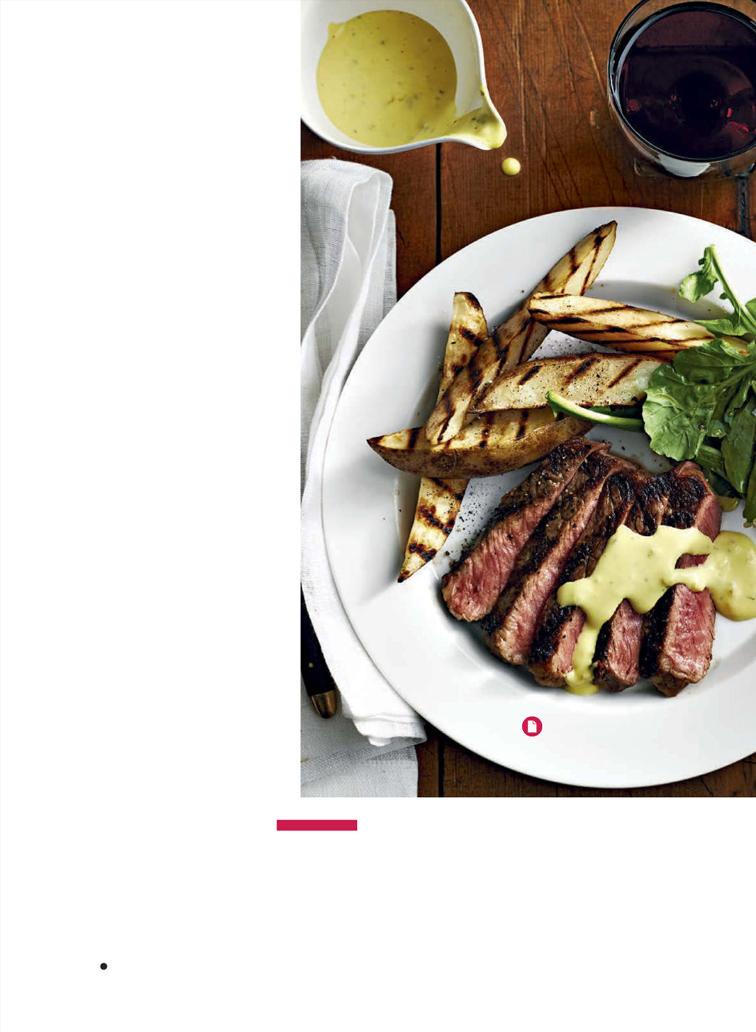
PER SERVING: about 557 cal, 35 g pro, 45 g total fat (21 g sat. fat), trace carb (trace dietary fibre, trace sugar), 251 mg chol, 369 mg sodium, 408 mg potassium. % RDI: 3% calcium, 29% iron, 20% vit A, 12% folate.
CHANGE IT UP Steakhouse Rib Eye With Shallot-and-Herb Compound Butter
In skillet, melt 1 tbsp butter over medium heat; cook 1 cup chopped shallots and 4 cloves garlic, minced, until shallots are softened, about 6 minutes. Let cool. In bowl, stir together shallot mixture; ½ cup butter,
FOR MORE BARBECUE RECIPES
AND TIPS, LOOK FOR CANADIAN LIVING’S SPECIAL ISSUE, BBQ BEST, ON NEWSSTANDS THIS MONTH.
softened; ¼ cup each chopped fresh basil and chopped fresh parsley; and 1 tbsp white wine vinegar. Scrape onto piece of plastic wrap and shape into 1-inch (2.5 cm) thick log; wrap tightly. Refrigerate until firm, about 30 minutes. (Make-ahead: Refrigerate for up to 3 days or freeze in freezer bag for up to 2 weeks.) Cook steaks as directed; top with cubes of butter mixture.
If You Were Exposed to, or Harmed by, ASBESTOS or ASBESTOS-CONTAINING Products Made, Distributed or Sold by THE FLINTKOTE COMPANY or FLINTKOTE MINES LIMITED,
TYPES OF PRODUCTS
During the 1930s to the 1980s, products sold by The Flintkote Company and Flintkote Mines Limited (the “Debtors”) may have contained asbestos. These products could have included floor tile, roofing shingles, joint compound, cement pipe, asphalt and other products.
Persons or entities exposed to, or harmed by, the Debtors’ asbestos or asbestos-containing products may have personal injury, wrongful death or other claims against the Debtors. You do not need to (i) have been diagnosed, (ii) have symptoms, or (iii) be impaired to be affected by the Plan. If you believe you may have been exposed to, or harmed by the Debtors’ products, you may be entitled to vote on the terms of the Reorganization. You should carefully read this notice and the important documents located at http://www.flintkotebankruptcy.com.
PLAN OF REORGANIZATION
The Debtors have filed for bankruptcy. On February 9, 2015, the Debtors filed a modified Joint Plan of Reorganization (the “Plan”) with the United States Bankruptcy Court for the District of Delaware (the “Bankruptcy Court”). The Plan includes the terms of a settlement reached between the Debtors and their former indirect parent company, Imperial Tobacco Canada Limited (“ITCAN”). The Plan has been jointly proposed by the Debtors, the Asbestos Claimants Committee and the Future Claimants Representative (collectively, the “Plan Proponents”). As background, the Plan is a modified version of a bankruptcy plan on which Debtors previously solicited votes in 2008 and 2009, and which was confirmed by the Bankruptcy Court on December 21, 2012 (the “Original Plan”). A document describing the Plan’s changes (the “Disclosure Supplement”), which the Bankruptcy Court approved on March 17, 2015, and a copy of the Plan itself and voting materials (a “Resolicitation Package”), has been mailed to known holders of claims against the Debtors or their lawyers.

THE TRUST
The Plan provides for a trust to be established to pay eligible asbestos personal injury claims against the Debtors (the “Trust”). The Plan states that all current and future holders of asbestos personal injury claims will be forever prohibited from asserting claims directly against the Debtors and other parties protected under the Plan, including ITCAN. Such persons can receive money only from the Trust. The Plan and the Disclosure Supplement have important additional details and are available at http://www.flintkotebankruptcy.com. SUPPLEMENTAL SETTLEMENT BAR ORDER
Under the Plan, ITCAN will also obtain protection from certain claims by a settlement bar order, which is described more particularly in the Plan and Disclosure Supplement.
VOTING PROCEDURES
The Bankruptcy Court has issued an order describing who can vote on the Plan, how to vote, and how votes will be counted. The Disclosure Supplement has information that will help you decide whether and how to vote on the Plan if you are entitled to do so. Votes cast on the Original Plan will be counted as votes on the Plan, unless a holder changes such vote. If you voted on the Original Plan and
do not wish to change your vote, you do not need to submit a
ballot. If you did not vote on the Original Plan, you may obtain and cast a ballot, which would be subject to the Plan Proponents’ right to object. To be counted, a completed ballot must be
received by the Voting Agent at the address below by 4:00 p.m. (prevailing Eastern time) on June 2, 2015. Any ballot received after that deadline will not be counted.
Proof of an asbestos personal injury or wrongful death claim does not need to be filed with the Bankruptcy Court. Special procedures have been established for holders of asbestos personal injury and wrongful death claims to vote on the Plan. Lawyers for holders of these claims may vote on the Plan on behalf of their clients if authorized by their client. If you are unsure whether your lawyer is authorized to vote on your behalf, please contact your lawyer.
THE HEARING TO CONFIRM THE PLAN
A hearing to confirm the Plan will be held before the Honorable Mary F. Walrath, United States Bankruptcy Judge, at the United States Bankruptcy Court for the District of Delaware, 824 Market Street, 5th Floor, Wilmington, Delaware 19801, commencing on August 10, 2015 at 10:30 a.m. (prevailing Eastern time). You may attend the hearing but are not required to do so.
OBJECTING TO THE PLAN
Objections to the Plan are limited to changes between the Original Plan and the Plan and must be submitted in writing
and received by July 8, 2015 to be considered. All objections must comply with the requirements in the notice of the Confirmation Hearing, available at http://www.flintkotebankruptcy.com.
HOW TO OBTAIN DOCUMENTS
If you would like additional information about the Plan, Disclosure Supplement and the Trust (including copies of the Plan and the Disclosure Supplement), you may contact the Debtors’ Voting Agent at (800) 290-0537 or visit http://www.flintkotebankruptcy.com.
1-800-290-0537










